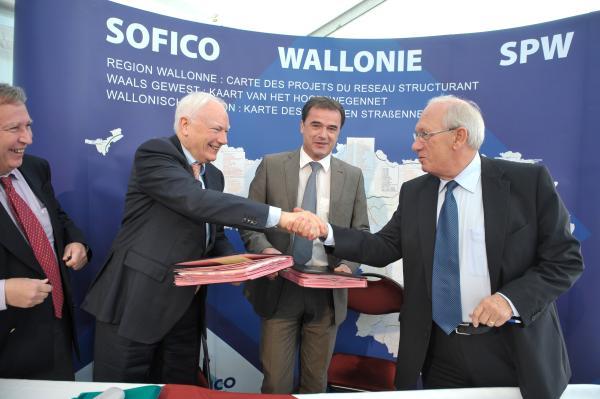
Belgium is at the crossroads of several major North-South and East-West transport arteries(1). And at the intersections of these European road and inland waterway corridors numerous bottlenecks in the TENs (priority trans-European transport networks) have long been identified in the Walloon Region and must be removed.
Transit traffic is extremely dense and has grown enormously on the Walloon road network (up to 35% consists of HGVs, three times as much as on other networks), leading to the deterioration of communication links – a situation that urgently requires major construction and upgrading works to be carried out on the roads and inland waterways across the region.
The EIB, the EU’s financing institution, will be a partner in these major works as part of its support for EU transport policy – a priority objective combining regional integration and economic development with the construction of modern, safe and sustainable transport infrastructure.
I. On the road network: improving safety and mobility
The EUR 250 million loan for the regional road network will be devoted to rehabilitating and upgrading roads, motorways and bridges on the trans-European transport network (TEN-T) and/or in convergence areas, all of which also form part of the Walloon Region’s infrastructure network. The project also includes safety and user service improvements (enlargement of HGV parking areas, construction of slip roads and roundabouts) and environmental measures (noise barriers and upgrading of stormwater basins).
To obtain the loan, Minister Lutgen carried out a series of reforms designed to meet the EIB’s eligibility requirements:
1. Defining Wallonia’s “infrastructure network”: the main arteries of this network – selected on the basis of objective criteria – consist of all motorways and their access roads, which belong to the trans-European network (roads assigned an “E number”), and strategic regional roads for interregional transport. The infrastructure network covers 1 800 km and accounts for 52.3% of road traffic on the regional network (2).
2. Establishing a “Roads Plan” for the comprehensive rehabilitation of the entire regional road network. A hierarchy of priority works on the infrastructure network was established on the basis of objective criteria particularly including safety, mobility and quality. To upgrade the whole network, 575 individual schemes were identified, of which 434 qualify for EIB support. Thanks to the EIB loan, it will be possible to implement nearly 75% of the “Roads Plan” within the next five years.
3. Clarifying the responsibilities of SOFICO and the Roads Directorate of SPW (Public Service of the Walloon Region). A single operator, SOFICO (Société wallonne de financement complémentaire des infrastructures), is now in charge of the infrastructure network and responsible for financing, repairing, maintaining and operating it (roads, equipment and surroundings). The Roads Directorate (SPW) concentrates on the secondary network.
II. On the inland waterways network: removing bottlenecks and promoting intermodal transport
The EUR 125 million EIB loan for Wallonia’s inland waterways will specifically finance the construction of two new 225m x 25m locks at Lanaye and Ivoz-Ramet and dredging works between the municipalities of Flémalle and Seraing. Both schemes are located on the Rhine/Meuse-Main-Danube priority trans-European corridor.
Although these two sites see the largest volume of inland waterway traffic in the Walloon Region (in 2009, 9.6 million tonnes at Lanaye, 10 million tonnes at Ivoz-Ramet), the locks have reached saturation point and any problems result in traffic hold-ups that are harmful to economic activity.
Covering 450 km, the Walloon Region’s inland waterways network is one of the densest in Europe and is used to transport nearly 40 million tonnes of goods a year. Linking together the region’s industrial hubs, but also connecting to national and international sea ports, it is a vital economic tool. The planned works are designed to integrate Wallonia’s network into the European inland waterways network, especially by increasing its capacity. But they will also serve to develop the river ports and foster intermodal transport with benefits for economic growth in the Walloon Region.
In order to get the EIB on board and secure rapid funding for these schemes, the financing and operation of this infrastructure was also entrusted to SOFICO.
For Minister Lutgen, the “European” financing obtained from the EIB is attractive, not only because of the favourable terms and long maturity enabling these large-scale works to be carried out in a few years, but also because it represents a pledge of confidence in the eyes of the other lending organisations that will be approached later.
These contracts were signed on 25 October 2010 at the Thieu service station at the junction of the Mons-Paris motorways towards Brussels (E19) and Namur (E42), with a view over the Centre Canal and the Strepy-Thieu boat lift – a place that was especially chosen because the road and inland waterway systems run in parallel at this point and because it is only a few hundred yards away from both the Sart bridge-canal, a structure 500 m long and 50 m wide that enables the Centre Canal to cross the Thiriau du Sar valley, and a major crossroads between the N55 and N535 at the entrance to the town of La Louvière.
(1) The North-South corridor: from the South of Italy and Spain to the North Sea ports and transatlantic traffic via Antwerp, Amsterdam and Rotterdam. The East-West corridor: from London and Dunkirk, via the Escaut, Sambre and Meuse, to the Rhine, Danube and Black Sea and the new EU Member States.
(2) The Walloon Region’s network comprises 7 800 km of regional roads (1 250 km of motorways and 6 550 km of trunk roads), 700 km of provincial roads and 45 000 km of municipal roads.

Photographer: Isopix ©EIB
Download original

Photographer: Isopix ©To be defined
Download original

Photographer: Isopix ©To be defined
Download original

Photographer: Isopix ©To be defined
Download original

Photographer: Isopix ©To be defined
Download original